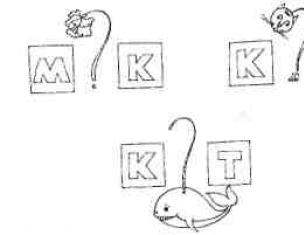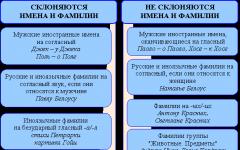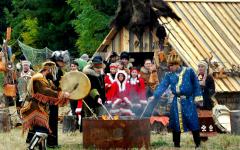from the 1957 rules are as follows:
* The principle of conveying akanya in words of foreign language origin has been expanded (for example, “adazhya”, “trya”, “salfedzhya” instead of writing these words with “o” at the end, “Tokіa” instead of “Tokіo”, etc.).
* In words of foreign language origin, except for proper names, the ends of the stems -er and -el are replaced with -ar and -al (for example, “kamp’yutar” instead of “kamp’yuter”, “pager” instead of “pager”)
* Writing the letter “ya” instead of “e” in the words “dzyavyaty”, “dzyasyaty”, “syamnatstst” and “vasyamnatstst” (before the introduction of the new rules it was written “dzevyaty”, “dzesyaty”, “semnatstst” and “vasemnatstst”)
* Writing the letter a instead of o in compound words, for example “garkam” instead of “garkom”, “gazpram” instead of “gazprom”, etc.
* Expansion of the spelling “e” instead of “e” in accordance with the phonetic principle (for example, “instance” instead of “instance”, “tunnel” instead of “tunnel”, etc.
* Unification of the spelling of adjectives in “-ski”, formed from proper names, all of them are written without softening (for example, if, according to the old rules, “Changchunski” and “Qianshanski” were written with a soft sign before “-sk”, and “Lyubanski” and “ Astrakhan" - without a soft sign, then according to the new rules they are all written without a soft sign)
* Expansion of the spelling of the short (“ў”) into words of foreign language origin (for example, “pa ўnіversіtetu” instead of “pa universitetu”, “heta unique raspratsouka” instead of “heta unique raspratsoўka”)
* Streamline the writing of uppercase and lowercase letters in the names of government bodies, organizations, titles, ranks, positions. WITH capital letters are written “The Council of the Minister of the Republic of Belarus”, “The Constitutional Court of the Republic of Belarus”, “The Government of the Administrative Office of the President of the Republic of Belarus”, “Patriarchal Exarchs of Belarus”, etc.
* Capitalization of the names of deities and their derivatives, as well as terms of similar meaning (“God”, “Yahweh”, “Usyashni”, “Uladyka of Heaven”, “Holy Trinity”)
* Writing the letter “ё” instead of the combination of letters “yo” at the beginning and middle of foreign words (for example, New York instead of New York, Yorkshire instead of “Yorkshire”.
* Simplification of transfer rules (if there is a combination of consonants in the middle of a word, transfer can be carried out anywhere (for example, “sya-stra”, and “syas-tra”, and “syas-ra” are allowed, instead of transferring strictly by syllables according to previous rules).
The law establishes a 2-year transition period, during which the old and new rules will function in parallel, but from 2010 there will be a final transition to the new rules.
The developed rules are the most optimal in today's conditions and meet the requirements of modern language practice. The proposed changes and clarifications do not affect the main provisions Belarusian spelling and ensure the continuity of the Belarusian written language
45. Belarusian State University: past, present, future
(For general development, will come in handy)
In 2011, the Belarusian State University celebrated its ninetieth anniversary. BSU has a glorious history and continues to develop wonderful traditions, which for many years have been supported by several generations of the university staff, students, graduate students, and its graduates.
Rector of BSU - Sergey Vladimirovich Ablameiko- Belarusian mathematician, prominent specialist in the field of computer science and information technologies, Image Processing and Pattern Recognition, Dr. technical sciences(1990), professor (1992), academician of the International Academy of Sciences of Information, Information Processes and Technology (1995), academician of the Belarusian engineering academy(1995), corresponding member (2004), and since 2009, academician of the Academy of Sciences of Belarus. Rector of Belorussian state university from October 31, 2008. Laureate of the State Prize of Belarus (2002), awarded the Francis Skaryna Medal (2007).
On October 30, 1921, the official opening of BSU took place. The first rector of BSU was an outstanding historian-Slavist professor Vladimir Ivanovich Picheta. He headed BSU for 8 years and contributed huge contribution in development high school Belarus.
In February 1925, the first graduation of specialists took place - 34 economists and 26 lawyers. In October 1927, a graduate school was opened at BSU. In the autumn of the same year, construction of a university campus began in the center of Minsk. With the active participation of BSU, new higher educational institutions were created in the Belarusian capital: Minsk medical school, Supreme pedagogical institute, Institute National economy, Belarusian Polytechnical Institute, Minsk Law Institute.
In June 1941, BSU was preparing to celebrate its 20th anniversary. However, the treacherous attack of the Nazi invaders disrupted all plans. In the very first days of the Great Patriotic War 450 volunteers from among teachers and students went to the front. For courage and bravery shown during the war, 12 employees and students of BSU were awarded high rank Hero Soviet Union.
IN post-war years New specialties and faculties are opening at BSU. Awarding July 7, 1967 BSU Order of the Red Banner of Labor became evidence of recognition of his merits in the field of science, education and culture.
Today BSU is leading higher educational institution in system national education The Republic of Belarus and a large educational, scientific and production complex, in which, along with faculties, there are many research institutes and centers, manufacturing enterprises. To improve the effectiveness of its activities, the university developed and implemented a quality management system in 2010 in accordance with the requirements of STB ISO 9001-2009.
Training of specialists with higher education 55 specialties are taught at 16 faculties(biological, military, humanitarian, geographical, historical, journalism, international relations, mechanics and mathematics, applied mathematics and computer science, radiophysics and computer technology, philosophy and social sciences, chemical, philological, physical, economic, legal), at the Institute of Journalism, State Institute management and social technologies, Institute of Business and Technology Management, Institute of Theology named after Saints Methodius and Cyril.
In 48 specialties, specialists are trained in master's programs according to the curricula of the second stage of higher education. Over the past two years, training has been introduced for nuclear energy, logistics, aerospace electronics and information systems and technologies, applied computer science, applied mechanics, literary work (creativity), etc. Pre-university training is carried out by the Faculty of Pre-University Education. The university includes a lyceum and a law college.
Retraining and advanced training of specialists with higher education is carried out at the Institute of Journalism and at the following educational institutions of the BSU complex: Republican Institute of Higher Education, Institute of Retraining and Advanced Training of Judges, Prosecutor's Office Workers, Courts and Justice Institutions, Institute of Information Technology and Management, Institute of Business and Management technology, Institute continuing education. The BSU complex also includes 4 research institutes, 25 scientific centers; 115 research laboratories, 12 unitary enterprises; 3 training and experimental stations; 3 museums.
There are 11 doctoral students, over 620 graduate students, and 28.5 thousand students studying at BSU. The personnel of the BSU complex includes about 7,500 people working on a permanent basis, of which 2,475 are teaching staff, scientific workers– 638 people. 6 academicians and 7 corresponding members of the National Academy of Sciences of Belarus, 287 doctors of science and 1,370 candidates of science work at BSU on a permanent basis.
The university includes a lyceum and a law college. The BSU complex also includes 4 research institutes, 25 scientific centers, 115 research laboratories, 12 unitary enterprises, 3 educational and experimental stations, 3 museums.
Among honorary professors of BSU laureate Nobel Prize Zh.I. Alferov, President of Kazakhstan N.A. Nazarbayev, President of Azerbaijan I.G. Aliev, rector of Moscow State University. M.V. Lomonosov Academician of the Russian Academy of Sciences V.A. Sadovnichy and other prominent scientists and statesmen from 13 countries of the world.
Over the years of its activity, the university has trained about 142.5 thousand specialists with higher education. Among its graduates are prominent scientists: Heroes of socialist labor L.A. Artsimovich, N.A. Borisevich, A.N. Sevchenko, F.I. Fedorov, author of two discoveries in nuclear physics V.G. Baryshevsky, RAS academician V.S. Stepin, writers Kuzma Chorny, Kondrat Krapiva, Ivan Melezh, Ivan Naumenko and other famous figures who made a significant contribution to the economy, education and culture of our country.
Today BSU is a leader in Belarus in training personnel for foreign countries. About 2000 students from more than 50 countries study at the university educational programs at various levels. The Belarusian State University has 251 international agreements with educational and scientific institutions of foreign countries. Relations with universities in Russia, Ukraine, Poland, China, Germany, Vietnam, France, Lithuania, Latvia, Sweden, and Spain are most actively developing. BSU is a member of the European and Eurasian Association of Universities, the coordinator from the Republic of Belarus in the university network of the Central European Initiative, participates in the activities of the Belarusian Association for the United Nations, the Interuniversity Center for Research and Cooperation in Eastern and South-Eastern Europe.
Transferring to the younger generation all the talent and rich experience, knowledge, warmth of their hearts, the university staff preserves and enhances the glorious traditions of generations and, having inherited all the best, makes an invaluable contribution to the organization of the educational process.
The training of journalists at BSU began on November 1, 1944. By decree of the Central Committee of the All-Union Communist Party of Bolsheviks, the first faculty of journalism in the Soviet Union was created in Minsk (at the universities of Kyiv and Moscow, faculties of the same name arose a little later - in 1946 and 1947, respectively.) But specialized training of journalists in Belarus began much earlier: 1918 - a school of journalism was opened on the basis of provincial party schools in Vitebsk, 1920 - the Institute of Journalism appeared in Minsk. From 1932 to 1941, journalistic personnel were trained at the Minsk Communist Institute of Journalism (KIZh), and from 1935 - at the Mogilev Newspaper College.
On November 1, 1944, classes at the journalism department of BSU began immediately in the first and second years, where 30 and 11 students studied. Liberated Minsk lay in ruins, there was no university building, there was also no faculty - at first classes were held at the Skhodnya station, then in school classrooms in Minsk.
The first teachers of the department were famous scientists and teachers: M. G. Larchenko, V. V. Gutorov, M. I. Zhirkevich, I. V. Zazeka. The first dean was teacher M. V. Lis, the head of the journalism department was associate professor D. Ya. Faktorovich.
On April 5, 1946, the Department of Journalism was formed. It was headed by military journalist and scientist M. S. Zernitsky. Since 1948, G.S. Akulov, a former employee of the Pravda newspaper, was invited from Moscow to the position of head of the department.
Until 1967, future journalists studied at the journalism department of the Faculty of Philology of BSU. In 1949, the first graduation of student journalists took place. Since that first graduation, three of them devoted their lives to work at their native faculty: Professor E. L. Bondareva, Professor M. E. Tikotsky, Associate Professor N. A. Snitsereva. Many of them became famous writers, playwrights, journalists: Hero of the Soviet Union, doctor historical sciences A. A. Filimonov, journalist A. D. Krasnoperko, in whose honor a prestigious journalistic prize was established, poets N. Ya. Avramchik, B. Curto, Honored Cultural Worker of Belarus E. P. Vladimirova.
In 1967 . first dean independent educational unit of BSU - Faculty of Journalism- became a professor, a former military officer Soviet army Grigory Vasilievich Bulatsky. From 1980 to 1986, Professor P. I. Tkachev worked as the dean of the faculty, from 1986 to 1996 - Professor O. G. Sluka, in 1996 - Associate Professor P. L. Doroschenok, from 1996 to 2005 - Associate Professor V. P. Vorobyov, since 2005 – associate professor S. V. Dubovik.
The faculty grew and gained strength every year. New departments were created, new ones appeared scientific directions. In 1965, two departments were created on the basis of the Department of Journalism: the history of journalism and the theory and practice of journalism. Department of History of Journalism, which was headed by different years M. S. Zernitsky, G. V. Bulatsky, now called the Department of History of Journalism and Literature (headed by Associate Professor P. L. Doroshchenok). Tikotsky Mikhail Evgenievich
The Department of Theory and Practice of Journalism subsequently became known as the Department of Theory and Practice of Soviet Journalism. In 1969, the famous journalist, Professor B.V. Streltsov was elected head of this department.
In 1968, the Department of Television and Radio Broadcasting was created. The first head was a journalist, scientist - associate professor N. E. Dostanko, then it was headed by a radio journalist, professor E. R. Radkevich.
The founder of the Department of Stylistics and Literary Editing was the famous scientist and teacher, Professor M.E. Tikotsky, in 1969. In 1984, the Department of Foreign Journalism and Literature was created, headed by Professor I. I. Sachenko. In the assembly hall
In the 80s, the Faculty of Journalism had 5 departments, photo, television and radio laboratories. The modernization of the educational and research process at the faculty, due to new prospects for the development of journalism, required an increase in the number of departments as centers of scientific, educational, methodological and educational work.
New opportunities opened up for the Faculty of Journalism in the second half of the 90s. In 1998, the faculty already had eight departments. The departments of periodical press (headed by associate professor A.K. Svorob), sociology of journalism (headed by associate professor V.P. Vorobyov), literary and artistic criticism (headed by associate professor L.P. Saenkova), and in 1999 the department of technology were formed communications (head – associate professor V. R. Vashkevich). And in 2005, the ninth department began its work - the Department of Theory and Methodology of Journalism (headed by Associate Professor S.V. Dubovik).
Over the years, journalists at the faculty received diplomas famous poets and prose writers M. Avramchik, I. Chigrinov, I. Ptashnikov, A. Vertinsky, B. Sachenko, V. Zuyonok and others. Almost 90% of the managers and employees of national media are graduates of the Faculty of Journalism of BSU.
On February 12, 2008, President of Belarus Alexander Lukashenko visited the Faculty of Journalism of BSU and spoke to students on the topic “Belarus in modern world". In February 2008, the Faculty of Journalism of BSU moved from Moskovskaya St., 15 to Kalvariyskaya St., 9.
The Faculty of Journalism of the Belarusian State University was transformed into the Institute of Journalism of the BSU on September 1, 2008.
Related information.
Belarusian and Russian orthography are based on phonetic And morphological principles. The extent to which these principles are spread in Belarusian and Russian orthographies is not the same.
In Belarusian orthography, phonetic and morphological principles are equal, in Russian - the basis is morphological principle. The phonetic principle in Belarusian orthography is most consistently maintained in the recording rules vowel sounds; in accordance with it is transmitted akanye And yacking: mountains - gara, forest - lyasny. After hard and hardened consonants zh, sh, ch, ts, j, r, in accordance with pronunciation, a, e, o, u, s are written, after soft ones - i: zherdka, shests.
A deviation from the phonetic principle in the spelling of vowels is the preservation of the root I in the words memory, dzevyats, writing uh, uh not under stress in borrowed words: theater, atelye.
The spelling of consonants in accordance with pronunciation is presented in Belarusian orthography. This includes the spelling of prefixes h: h written before voiced consonants and sonorant vowels; With- before voiceless consonants: razbshch, zrabshch, but upomnshch, hibernation. TO phonetic include writing w in the words shchastse; reflection on the letter of prefixed consonants (vozera, but azerny; vuchan, but unuk, etc.), dzekanya And tskating.
In accordance with the morphological principle, voiced ones are written before voiceless consonants and at the end of words, voiceless ones before voiced ones, including at the junction of morphemes: garden, bread, tale, fish, jump, request. Root d, t, before ts, h in the Belarusian language they are also expressed invariably: adjuster, perakladchyk,.
Writing loanwords in Russian this is the spelling of words with double consonants: metal, grammar; in the Belarusian language - transmission of unstressed e, e excluding acaña: season, peron. Writing homonyms and proper names: Russian. company - campaign, eagle; white Arol.
Traditional spellings are more widely represented in Russian orthography than in Belarusian. TO traditional spellings in Russian refer to the spelling of a letter b after f, w in the forms of verbs of the second person singular of the present tense - read, write, feminine nouns of the third declension - rye, mouse. In the Belarusian language, as in Russian, the traditional principle determines, for example, the writing of a capital letter in the names of international organizations (Argashzatsyya Ab"yadnannyh Nations).
Spelling rules not related to the transmission of sounds are in most cases the same in the Belarusian and Russian languages. This includes the rules for placing punctuation marks, the use capital letters continuous and separate spelling, rules for hyphenating words, spelling with a hyphen, spelling of compound words, letter abbreviations and graphic abbreviations
The new Spelling Rules for the Belarusian language were once again discussed at the end of last week, when Minister of Education Alexander Radkov was at a reception with Alexander Lukashenko. Then the words were said that “language, like a living being, developed, filled and improved. And the Rules were last adopted in 1957.” Therefore, the new Rules must be written in a clear and accessible way so that they can be used, including by schoolchildren, teachers and journalists.”
What specific changes await the Belarusian language? Many possible answers immediately appeared. They say that the Belarusian language is getting closer and closer to Russian, that the rules for writing proper names will be changed: Mikola will become Mikalay, and Zmitser will become Dzmitry, and the apostrophe may disappear from the language altogether.
Most of all, the public was confused by the fact that the preparation of the project was entrusted to the Ministry of Education, and that only two weeks were given for development. In fact, the document, fateful for the language, has been being prepared for more than one year - the State Commission was created back in 1998.
We are not talking about any reform, only about changes, says the co-chairman State Commission, Doctor of Philology, Professor Viktor IVCHENKOV. - The new edition of the Rules of Belarusian Spelling and Punctuation is aimed at eliminating numerous exceptions. The draft of the new edition of the Rules was developed by the Institute of Linguistics of the Academy of Sciences in 1997-98 and was finally finalized this year. On the initiative of the Ministry of Education, it was created working group under the scientific guidance of Doctor of Philology, Professor, Director of the Institute of Linguistics Alexander Lukashanets and mine.
What changes are we talking about?
Now in the Belarusian language there will be very precise, specific, logically verified Rules. For example, “o” is written only under stress, there will be no exceptions. We propose to extend the law of akanya to all words. And write not “adazhyyo”, “three”, but “trya”, “adazhya”, “Tokia” and so on.
What about the radio?
This one word will remain an exception. The changes also apply to the “y” of the non-warehouse. It will be written in borrowed words both at the beginning of the word and where it closes the syllable: va university, auktsyyon, fauna, aura, mauser, audyokaseta.
The capital letter has undergone changes. We still wrote the National Assembly with a small letter, and the Dzyarzhaunaya Duma with a capital letter. This discrepancy has now been resolved. Spelling standards will stipulate that the names of the highest authorities - executive, legislative, judicial - are written with a capital letter. It is difficult to list all the changes; the commission members worked very seriously.
An unknown exception was thrown when soft sign written in relative adjectives of Chinese origin: Tien Shan, but Luban. Now all these adjectives will be written without a soft sign.
The soft sign will not return between consonants - “snow” or “snow”?
In no case. This will throw the Belarusian language back a century. In the last century in the Russian language there was solid sign at the end of words. The language should be convenient, economical, and should not be cluttered with uninformative signs.
Back to top school year the new Rules will not be approved yet?
Naturally not. We are talking only about preparing a package of documents. After it is accepted by the head of state, a mechanism and timing for introducing the new edition will be developed. Perhaps in a year or two both the old and new Rules will be taken into account.
ANOTHER VERSION
Vintsuk VECHERKO: I don’t expect anything good from the reform
My colleagues and I have been engaged in the further development of the classical tradition of spelling, Tarashkevitz, for decades. Two years ago there was a presentation of the book “Belarusian Classical Orthography”. This book develops the tradition of Tarashkevich, taking into account modern conditions.
In the early 90s, classical spelling began to dominate the Belarusian-language Internet and appeared in some newspapers - “Svaboda”, “Nasha Niva”. Nothing good from new reform I'm not waiting. This reminds me of the reform of 1933, when the Bolsheviks, in the 13th year of their rule in Belarus, changed the Belarusian language, bringing it closer to Russian.
The Belarusian Language Association and the Union of Belarusian Writers know nothing about the reform.
It would be better if there were two options. There was bivariance in Greek literary language. And today it is in Norwegian.
HOW IT WAS
The language flourished at the beginning of the twentieth century
1589 The Belarusian language has been officially approved as the state language in the Grand Duchy of Lithuania.
1696 The authorities of the Polish-Lithuanian Commonwealth transferred the language to the category of “peasant language”. But neither the Poles nor the Russian autocrats were able to accustom the Belarusians to a foreign language.
1906 The first Belarusian-language newspaper “Nasha Niva” was published in Vilna. The texts were printed in both Cyrillic (for eastern regions) and Latin (for western regions). The “Belarushchyna” boom has begun. We have world-class writers, poets, and our own world-famous scientists.
1918 Branislav Taraszkiewicz published “Gramatyka for schools”. Already in 1923, almost the entire bureaucracy, intelligentsia and ordinary people spoke Belarusian.
1927 The Constitution defined Belarusian as the main language in the BSSR.
1933 Stalin's repressions greatly undermined the national intelligentsia. Almost all spelling developers were imprisoned or shot. It was decided to hold a new conference on changing the spelling. The Belarusian language has been simplified and brought closer to Russian. For example, they removed the assimilated softness (sneg - snow), introduced uncharacteristic endings, changed the spelling of borrowed words (dyyaleg - dyyalog). In addition, they cut out a whole layer of native vocabulary, replacing it with Russian tracings (dahoўka - charapitsa, mapa - map, zamnaya kulya - zamny shar).
1959 Made minor changes to spelling rules. In fact, this is the Belarusian language we still use today.
The Belarusian language will sound in a new way from September 1, 2010. In accordance with the law “On the Rules of Belarusian Spelling and Punctuation,” the rules for writing individual words will change from the beginning of the next academic year.
According to the Ministry of Education of the Republic of Belarus, the bill, in particular, expands the principle of rendering “akanya” in words of foreign origin, makes changes to the spelling of complex abbreviated words, expands the use of “ў” in words of foreign origin and simplifies the rules for hyphenation. In addition, it regulates the spelling of the names of government bodies, organizations, enterprises, as well as positions and titles.
As noted by the Ministry of Education, new rules of spelling and punctuation of the Belarusian language will be introduced gradually. Until 2010, the use of both options is allowed.
Rules for switching to a “new” language
1. The principle of conveying “akanya” when writing words of foreign origin is expanded. It is proposed, for example, to write: “trya”, “adazhya”, “Tokіa” instead of “tryo”, “adazhyo”, “Tokіo”, as Belarusians now write. In words of foreign origin at the end of which “-er”, “el”, from September 1 there will be “-ar”, “-al”: “pryntar”, “kamp’yutar”, “pager” instead of “prynter”, “kamp’ yuter", "pager".
2. The use of “ў” in words of foreign origin is expanding. For example, it would be correct to write: “va universitetse”, “grazing a unique operation”, “fauna”, and not “va universitetse”, “grazing a unique experiment”, “fauna”, as we write now.
3. In accordance with modern language practice, changes are being made to the spelling of complex and abbreviated words. For example, it is suggested to write: “garkam”, “gazpram” instead of “garkom”, “gazprom”.
4. In adjectives ending in “-sk(i)”, created from proper names, the soft sign is not written: “Chanchunski”, “Qianshanski” instead of “Changchunski”, “Qianshanski”.
5. The spelling of the names of government bodies, organizations, enterprises, institutions, as well as positions, ranks and titles, etc. is regulated. with a capital or small letter.
6. A new paragraph “Valikaya and Malaya Litars in the names of characters associated with religions, in the names of mythal and Cossack heroes” will be introduced. It is proposed to write with a capital letter the personal names of deities in religious cults, as well as all words in phrases that contain these names: “God”, “The Most High”, “Holy Trinity”, etc.
7. At the beginning and in the middle of words, the sound combination [th] + vowel is conveyed by iota vowels: “New York”, “Yofe”.
8. The use in the Belarusian language of verbs of foreign origin with the suffixes “–ava- (-java-)” and “–irava- (-yrava-)” is regulated: “likvidavats”, and not “likvidziravats”, “aklimatyzavac”, and not “aklіmatsіzіravac”, but “kamandziravats”, not “kamandavac”, “budziravats”, not “budavac”, etc.
9. The following sections have been excluded from the set of rules: “Galosnya in some non-National endings nazoўnikaў”, “Galosnyya in some endings of the prymetnika and busy”, “Galosnyya in some non-National endings of the dzeyaslova”. This is due to the fact that the provisions of these sections relate not to spelling, but to inflections and are reflected in the grammar of the Belarusian language.
10. Introduced new section“Pravapis of some Marthemes”, which systematizes material about the spelling of prefixes and suffixes.
11. The rules for word hyphenation have been simplified, which corresponds to modern publishing technologies.







